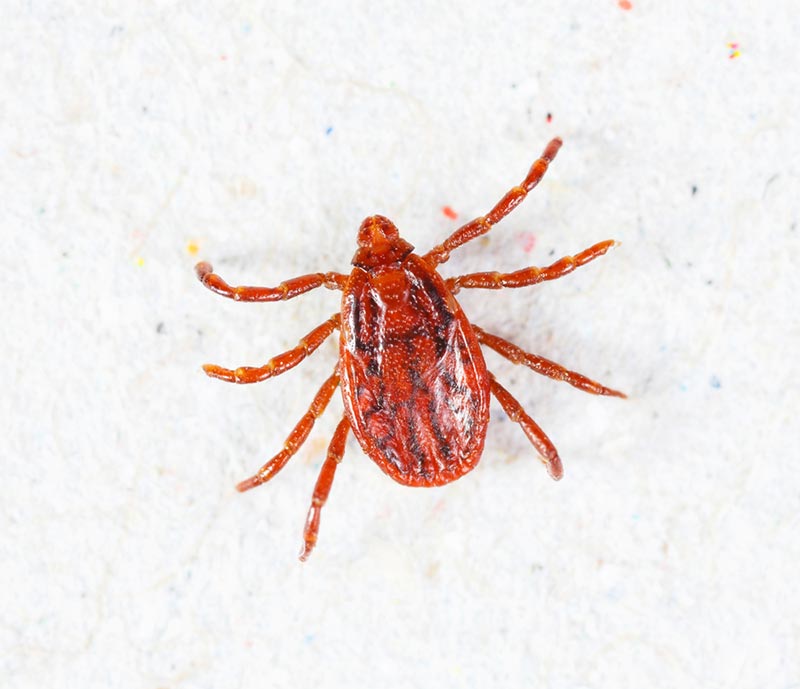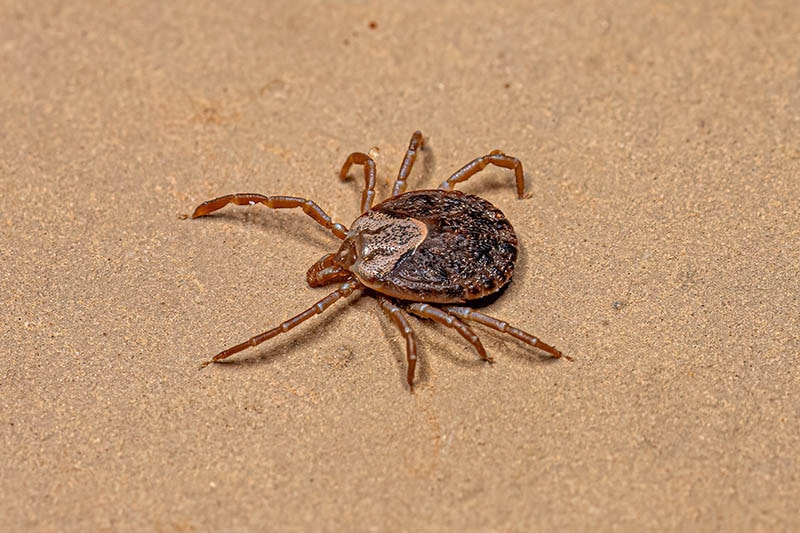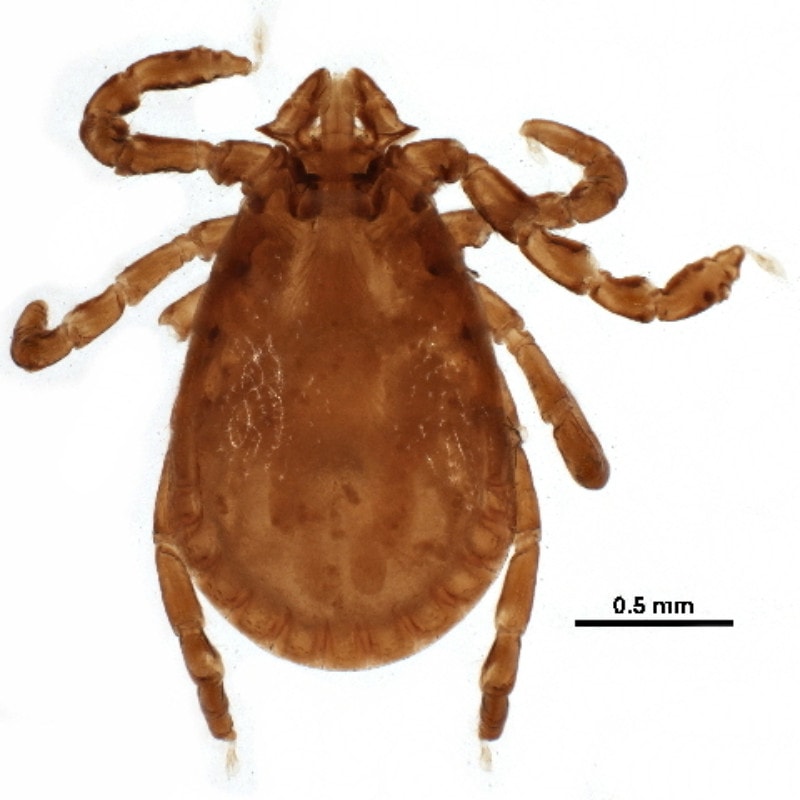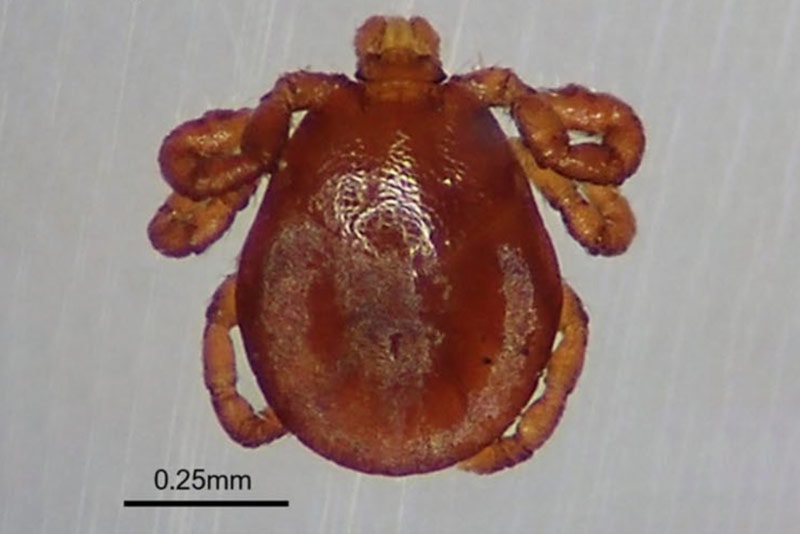9 Types of Ticks in Louisiana & Prevention Tips
-
Brooke Bundy
- Last updated:

If you like to hike during the summer months in shady areas with lush, green foliage, you probably are familiar with ticks. These small six-legged insects attach themselves to humans and animals to suck their blood for food. They’re extremely hardy creatures and can survive for two years without a meal. Additionally, their tough exoskeletons make them difficult to crush. Since certain tick species can carry different diseases, it’s important to learn how to identify the types that are commonly found in your area so that you can prevent them and remove them as quickly as possible if they’re attached to you or one of your pets.

The 9 Types of Ticks in Louisiana
1. American Dog Tick (Dermacentor variabilis)

Commonly known as wood ticks, these pesky creatures can be found anywhere in the United States that’s east of the Rockies. A small population also resides in California. They’re very prevalent in Louisiana, and unfortunately, they’re one of the tick species that’s most likely to bite humans. They can transmit Rocky Mountain spotted fever¹ (RMSF), one of the deadliest tick-borne illnesses with symptoms that can resemble the flu such as a high fever, aches, and a rash. They can also carry Tularemia¹, which is a bacterium that’s still serious but not as likely to affect humans.
As their name implies, they’re especially attracted to dogs but can also attach to you or your cats, so be sure to check yourself and your furry friends after your next walk in the woods or tall grass. The good news is that the American Dog Tick has a red-brown body that’s larger than most species that live in the Bayou state, so they’re not too hard to spot. Females have a creamy tan spot near the top of their bodies that’s similar to the design on a Lone Star Tick.
2. Blacklegged Tick (Ixodes scapularis)

The infamous Blacklegged Tick, also known as the deer tick, is the only species capable of transmitting Lyme disease¹ in Louisiana. One of the reasons this illness is so concerning is that it can have chronic, lingering effects, especially if it wasn’t diagnosed quickly. The Blacklegged Tick mostly lives east of Dallas, TX, and can be found all up and down the Atlantic coast. You can identify the deer tick by their distinctly black legs. Females have reddish-orange bodies, while males have dark brown bodies.
3. Brown Dog Tick (Rhipicephalus sanguineus)

Dog parents beware: the Brown Dog Tick can live year-round, indoors, on your dog. They’re one of the only species in the world that doesn’t ever need to go outside. If they have access to your dog for their food, they’ll never leave. These red-orange ticks are tiny when they’re hungry, but once they’ve feasted, they can swell up to nearly the size of a quarter. Luckily, this makes them pretty easy to spot, but try to catch them before they’ve had a meal to reduce your dog’s risk of developing diseases.
4. Gulf Coast Tick (Amblyomma maculatum)

These regional tick species look similar to a seashell with its tan mottling pattern. However, their potential effects are far from pretty. A bite can even have deadly consequences since Gulf Coast ticks carry a host of diseases, including Rocky Mountain spotted fever. Their mouths are larger than those of some other tick species, so much that you might mistake this species for a spider unless you count its legs. They live exclusively in the Southeastern United States, usually along the coast.
5. Lone Star Tick (Amblyomma amencenum)

Unfortunately, you don’t have to live in Texas to see this critter. You can find the Lone Star Tick practically everywhere east of Nebraska. Its name is derived from the single tan splotch that’s found on the back of females. While lone star ticks technically don’t transmit Lyme disease, they have been associated with illnesses that have similar symptoms such as Southern Tick-Associated Rash Illness (STARI)¹.
6. Groundhog Tick (Ixodes cookei)
This species is also known as the woodchuck tick. They like to stay in the forest where they feed off of small animals such as the rabbit and the fox. Their bodies are lighter than other tick species, especially females who have a cream-colored torso. Males have a plain brown body. Although they probably won’t bother you, they might latch onto your dog, so keep a close eye on your dog if you like to hike with them in wooded areas.
7. Cayenne Tick (Amblyomma cajennense)

With cayenne in its common name and “cajen” in its Latin root, this small tick sounds like it belongs in Louisiana. You won’t find this species in most places in the United States since they prefer a tropical climate. This tick has tan thick legs that look similar to those of a crab, and they have an interesting brown and tan pattern on their backs. They feast mostly on livestock animals, so humans don’t have to worry about them too much. However, if you see one attached to you, it’s important to remove it quickly because this species can transmit Rocky Mountain spotted fever.
8. Rabbit Tick (Haemaphysalis leporispalustris)

While you’ll need to keep an eye on small animals such as rabbits and ground-dwelling birds such as chickens, you shouldn’t worry about yourself because the Rabbit Tick isn’t known to bite humans. They’re brown with small bodies that are marginally bigger than a poppy seed.
9. Winter Tick (Dermacentor albipictus)

Since winter is a mild season in Louisiana, you may believe you’re safe from this tick. While Winter Ticks do prefer the blood of bigger hooved animals such as elk and moose, you can find them practically anywhere in North America, including Louisiana. The populations are more prevalent where there are hooved animals nearby, such as cows. Unlike most ticks, Winter Ticks remain with the same host for all three of their life stages, and they’re most active during the colder months.

How to Prevent Ticks
Flea and tick prevention for your pets and bug spray for yourself are the most well-known ways to prevent ticks. While DEET products will deter ticks, they’re typically frowned upon since they’ve been proven to not be the safest insect repellent. However, the good news is that ticks hate the smell of several common essential oils such as lemon and peppermint¹.
If you decide to go the natural route for you and your pets, make sure that you’re using the particular oils correctly without putting your animals in danger. Certain essential oils such as peppermint are actually considered toxic¹ to dogs and cats but may be safe for some uses. Dosage is typically the key. You might find peppermint oil in a natural flea and tick prevention products intended for dogs and cats because the risk of toxicity is low if you use as directed. Some essential oils are considered especially low-risk¹ such as lemongrass, lavender and citronella.
Since ticks can carry devastating diseases to you and your animals, it’s vital to keep an eye out for them, especially during the warmer months when they’re more active. Anytime you’ve been in a shady, wooded area, you should check yourself within a couple hours for ticks. You can usually find them in your groin or under arm area, or in your hair where they’ll try to seek shelter near your scalp. An attached tick might feel like a scab from a popped pimple until you try to loosen it and find that it’s connected to your skin.
How to Remove Ticks
If you’ve found a tick, don’t panic. Not every tick carries diseases, especially Lyme disease, and even the ones that do usually need to latch onto you for a few hours before any damage is done. Nonetheless, you want to remove it as quickly and safely as possible.
It’s important not to leave any trace of the tick behind, so you’ll want to use a pair of clean tweezers, grab its torso, and pull straight out. Don’t pull it out by one of its legs, or they might snap off, leaving part of its body attached to you. Once the tick is removed, make sure it’s dead by flushing it down the toilet or exposing it to isopropyl alcohol in a sealed sandwich bag. Never try to crush ticks. Not only is this method ineffective since ticks have tough bodies, but it can also put you at risk for disease.
Wash the site of the tick thoroughly with soap and water. Wash your hands. Clean and sanitize the tweezers with isopropyl alcohol.

Conclusion
While they might not be the most pleasant creature you’ll find on the trail, ticks are an inevitable part of outdoor summertime adventures. There’s no need to panic if you see a tick, but you’ll want to remove it from you or your dog as soon as possible to offset the risk of serious illnesses such as Lyme disease and Rocky Mountain spotted fever. Be sure to use bug spray during the warmer months and use some type of safe flea/tick prevention on your pets to reduce your exposure to ticks.
- https://www.cdc.gov/rmsf/
- https://www.cdc.gov/tularemia/
- https://www.cdc.gov/lyme/
- https://www.cdc.gov/stari/
- https://birdwatchinghq.com/ticks-in-louisiana/
- https://www.cdc.gov/stari/disease/index.html
- https://www.napamosquito.org/rabbit-tick-haemaphysalis-leporispalustris
- https://ldh.la.gov/assets/oph/Center-PHCH/Center-CH/infectious-epi/EpiManual/TickPreventionPublicInfo.pdf
- https://www.cdc.gov/ticks/geographic_distribution.html
- https://a-z-animals.com/blog/9-ticks-in-louisiana/
- https://www.farmersalmanac.com/7-natural-tick-remedies-work-27452
- https://www.caninejournal.com/best-flea-and-tick-prevention-for-dogs/
- https://www.petpoisonhelpline.com/blog/essential-oils-cats/
Featured Image Credit: Jerzy Górecki, Pixabay
Contents
